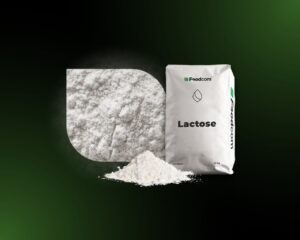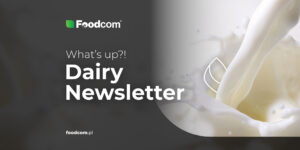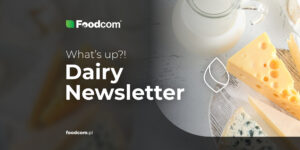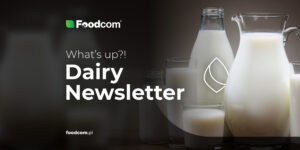- Stable SMP and cheese prices supported by balance of supply and demand.
- Butter production constraints and lack of imports from NZ keep prices high.
- High demand for SWP in Asia with limited production in Europe.
- New trade initiatives may affect competitiveness of EU producers.
Welcome Partners!
Welcome back to our newsletter!
In Q4 2024, European dairy markets show stable or slightly increasing prices in key product categories due to balanced supply and demand. Dairy powders remain resilient due to stable food prices driven by food industry demand, while cheese markets are stable, with stable prices in Central Europe and slight declines in the Netherlands. Limited milk production and import restrictions are keeping butter and AMF prices stable, and strong demand is likely to continue this trend until 2025. High demand and limited availability are supporting solid cream and whey powder prices, with whey seeing potential upward pressure from strong Asian demand and limited production.
Let’s see what else has happened recently in the dairy market!
Milk powder
The Skimmed Milk Powder (SMP) market for feed products shows stable prices, with a slight downward trend observed in Q4 at 2,400 EUR/MT. Forecasts for Q1 indicate a slight increase to 2,450 EUR/MT, suggesting a resilient market with little trading activity. Limited trading volumes may indicate potential supply bottlenecks, especially if demand increases or supply chains are disrupted.
For food grade SMP, prices remain stable due to strong demand in the food industry, particularly in sectors such as baking, desserts and beverage production. Prices for older SMP batches are at 2,350-2,400 EUR/MT, while prices for fresh SMP remain in the 2,400-2,450 EUR/MT range (FCA). European skimmed milk powder maintains a competitive position on world markets, although weak domestic demand and strong international competition pose challenges. Reduced milk production and export interest from regions such as Southeast Asia could put upward pressure on prices until 2025.
Cheese
The European Cheese market remains balanced, with stable prices for Gouda and Edam varieties , as supply and demand reach equilibrium. In Central Europe, especially in Germany and Poland, prices are stable, while in the Netherlands Gouda prices show slight decreases. It is worth noting that regional differences in availability persist, with smaller supplies of Gouda in Germany and Poland compared to the Netherlands. Producers continue to move stocks cautiously towards the end of the year, while consumer demand remains supportive, especially with Christmas consumption on the horizon. A balanced outlook is expected for early 2025, with possible price increases linked to stable demand and production levels in key European markets.
Fats
European Butter prices saw an upward movement in Q4, currently trading in a range of 7550-750 EUR/MT. German retail butter prices remain stable at 8,550-8,600 EUR/MT, maintaining October levels, while industrial butter in 25kg packs is trading at 7,700-7,800 EUR/MT, forecasting further strengthening in Q1. Looking ahead, forecasts for Q1 indicate that prices could remain above 7,300 EUR/MT, with speculative interest also pushing Q2 trade into the 6,900 EUR/MT range. Limited milk production, supply constraints and a lack of imports from New Zealand continue to support stable butter prices.
For Anhydrous Milk Fat (AMF), demand pressures coupled with limited supply could push prices slightly higher in 2025, especially as Asian markets look to European AMF to meet demand.
Liquids
The market for Cream in Europe remains strong, with prices ranging between 9,900 and 10,200 EUR/MT (FCA). High demand from sectors using high-fat dairy products, combined with limited availability, continues to support stable prices at this level. Particular demand during the festive season further reinforces this trend, making cream considered a high-value product, often chosen over processing into butter.
Prices for Skimmed Milk Concentrate remain stable in the range of 2,200 – 2,300 EUR/MT (FCA Germany) and slightly higher in the Netherlands at 2,250 – 2,300 EUR/MT (DAP). This price stability is due to the improved availability of the product, which has helped to alleviate recent market tensions and meet demand without pronounced price fluctuations. Balanced supply and management of stock levels are helping to maintain stability in the SMC market, which is forecasting similar conditions in early 2025.
The payout rate for Milk producers increased by €2 in November, reaching €55.50 per 100 kg, with a maximum potential payout of €61 per 100 kg. This increase reflects stable domestic demand and significant export opportunities, particularly to Asian markets. However, these higher payouts are unlikely to lead to increased production due to increased operating costs and the impact of the nitrogen reduction programme, which limits growth potential in rural areas. In Germany, milk prices are on the rise, while in Poland the average farmgate price has shown a slight decline in recent months, despite a year-on-year increase. Fresh milk prices are expected to remain stable or potentially show an upward trend, influenced by production levels and local demand.
Whey powder
The Sweet Whey Powder (SWP) market remains stable, trading at around 870 EUR/MT in Q4 and Q1 2025, reflecting reliable demand patterns in the animal feed sector. Global demand remains stable, particularly from China and Southeast Asia, supporting potential price levels. Production challenges in Europe, where liquid whey is increasingly destined for the higher-margin Whey Protein Concentrate (WPC) market, are adding to the complexity of the SWP supply chain. German SWP production has seen a significant year-on-year decline of 12%, while continued growth in cheese production may ultimately provide more liquid whey, helping to ease stresses. In the medium term, limited production combined with resilient demand signals may support a gradual upward trend in SWP prices until early 2025.
What else?
Global
Indo-Pacific Economic Framework (IPEF) is an initiative to promote trade and economic cooperation in the Indo-Pacific region. Trade experts estimate that the implementation of the Indo-Pacific Economic Framework (IPEF) could significantly impact the dairy industry. Expectations are high, especially in terms of trade facilitation and improved access to markets. Despite the progress of the talks, the details of regulation and protection of local producers from unfair competition remain key.
Oceania
New Zealand’s dairy giant, Fonterra, reported a slowdown in milk production growth in September. Unfavourable weather conditions and rising production costs contributed to a reduction in supply. Despite this, the company remains optimistic, citing innovation and increased efficiency as key elements of its growth strategy.
Europe
At the COGECA meeting on 29 October 2024, representatives of the European agricultural sector sharply criticised the trade agreement between the European Union and Mercosur countries. The concern is mainly about the impact on the competitiveness of European dairy producers, who have to meet strict quality and environmental standards. The agreement could lead to an influx of cheaper products, which poses a threat to the stability of the dairy sector in Europe.
![Christmas rush: are dairy prices rising or holding steady? [243rd DAIRY Newsletter Edition] Christmas rush: are dairy prices rising or holding steady? [243rd DAIRY Newsletter Edition]](https://foodcom.pl/wp-content/uploads/2024/05/Foodcom_SA_Dairy_Newsletter_1-1520x760.jpg)






